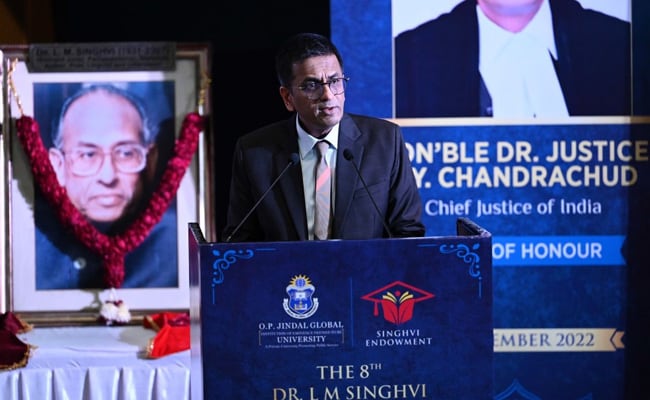
[ad_1]

Chief Justice made the remarks while delivering the Nani A Palkhivala Memorial Lecture. (File)
New Delhi:
Chief Justice of India DY Chandrachud on Saturday called the basic structure doctrine a North Star that guides and gives certain direction to the interpreters and implementers of the Constitution when the path ahead is convoluted.
The remarks by the CJI came against the backdrop of the recent remarks by Vice President Jagdeep Dhankhar who questioned the landmark 1973 Kesavananda Bharati case verdict that gave the basic structure doctrine. Mr Dhankhar had said the verdict set a bad precedent and if any authority questions Parliament’s power to amend the Constitution, it would be difficult to say “we are a democratic nation”.
Delivering the Nani A Palkhivala Memorial Lecture here, the CJI said craftsmanship of a judge lies in interpreting the text of the Constitution with the changing times while keeping its soul intact.
“The basic structure of our Constitution, like the north star, guides and gives certain direction to the interpreters and implementers of the Constitution when the path ahead is convoluted,” he said.
“The basic structure or the philosophy of our Constitution is premised on the supremacy of the Constitution, rule of law, separation of powers, judicial review, secularism, federalism, freedom and the dignity of the individual and the unity and integrity of the nation.”
The CJI said that from time to time, we require people like Nani Palkhivala, who was an eminent jurist, to hold candles in their steady hands to light the world around us.
“Nani told us that our Constitution has a certain identity which cannot be altered.” He said the doctrine of basic structure has shown that it might be beneficial for a judge to look at how other jurisdictions have dealt with similar problems for them.
The basic structure principle became the ground for setting aside several Constitutional amendments, including the quashing of the Constitutional amendment and the corresponding NJAC Act on the appointment of judges in the higher judiciary.
Mr Dhankhar, who is the Rajya Sabha chairman, recently said he does not subscribe to the Kesavananda Bharati case verdict that Parliament can amend the Constitution but not its basic structure. He had asserted that parliamentary sovereignty and autonomy are quintessential for the survival of democracy and cannot be permitted to be compromised by the executive or judiciary.
Addressing the 83rd All India Presiding Officers Conference in Jaipur on January 11, he said the judiciary cannot intervene in lawmaking.
“In 1973, a wrong precedent (galat parampara) started.
“In 1973, in the Kesavananda Bharati case, the Supreme Court gave the idea of basic structure saying Parliament can amend the Constitution but not its basic structure. With due respect to the judiciary, I cannot subscribe to this,” Mr Dhankhar, who has been a Supreme Court lawyer, said.
Mr Dhankar’s statement came against the backdrop of a raging debate on the issue of appointment to the higher judiciary with the government questioning the current Collegium system and the Supreme Court defending it.
In his lecture, Justice Chandrachud said the identity of the Indian Constitution has evolved through the interaction of Indian citizens with the Constitution, and has been accompanied by judicial interpretation.
“The craftsmanship of a judge lies in interpreting the text of the Constitution with the changing times while keeping its soul intact,” he added.
The CJI also observed that India’s legal landscape has undergone a significant change in the recent decades in favour of removing “strangulating regulations, augmenting consumer welfare and supporting commercial transactions”.
He said the emerging world economy has erased national boundaries, and companies no longer stop at the border.
“In recent decades, India’s legal landscape has also undergone a significant change in favour of removing strangulating regulations, augmenting consumer welfare and supporting commercial transactions.”
The CJI noted that legislations such as the Competition law and the Insolvency and Bankruptcy Code have been enacted to promote fair market competition. Similarly, the Goods and Services Tax (GST) has sought to streamline indirect taxation on the supply of goods and services in India, he added.
“If you look at the Constitution, it does not favour unbounded economic liberalism. Rather, our Constitution seeks to find the right balance.”
The CJI further said the Constitution allows the state to change and evolve its legal and economic policies to meet societal demands.
He said that when individuals have the opportunity to exercise their liberties and to be fairly rewarded for their efforts, then economic justice becomes one of the many inter-related dimensions of life.
Ultimately, we share common faiths and destinies to the point that development of each individual fosters social justice in the entire world, he added.
“We have come a long way from the time when getting a phone required you had to wait for a decade, and buying your car even longer at times. We have come a long way from the time of the control of capital issues,”he added.
Talking about Palkhivala and several prominent cases in which he was involved, the CJI said the eminent jurist was at the forefront of preserving the very identity and cardinal principle embedded in the Constitution.
“Nonetheless, the larger picture of legal culture and local dimensions of law, which are dictated by the local context, should never be obfuscated. Law is always grounded in social realities.”
(This story has not been edited by NDTV staff and is auto-generated from a syndicated feed.)
Featured Video Of The Day
Redmi Note 12 Pro+: All About the 200-Megapixel Camera
[ad_2]
Source Link